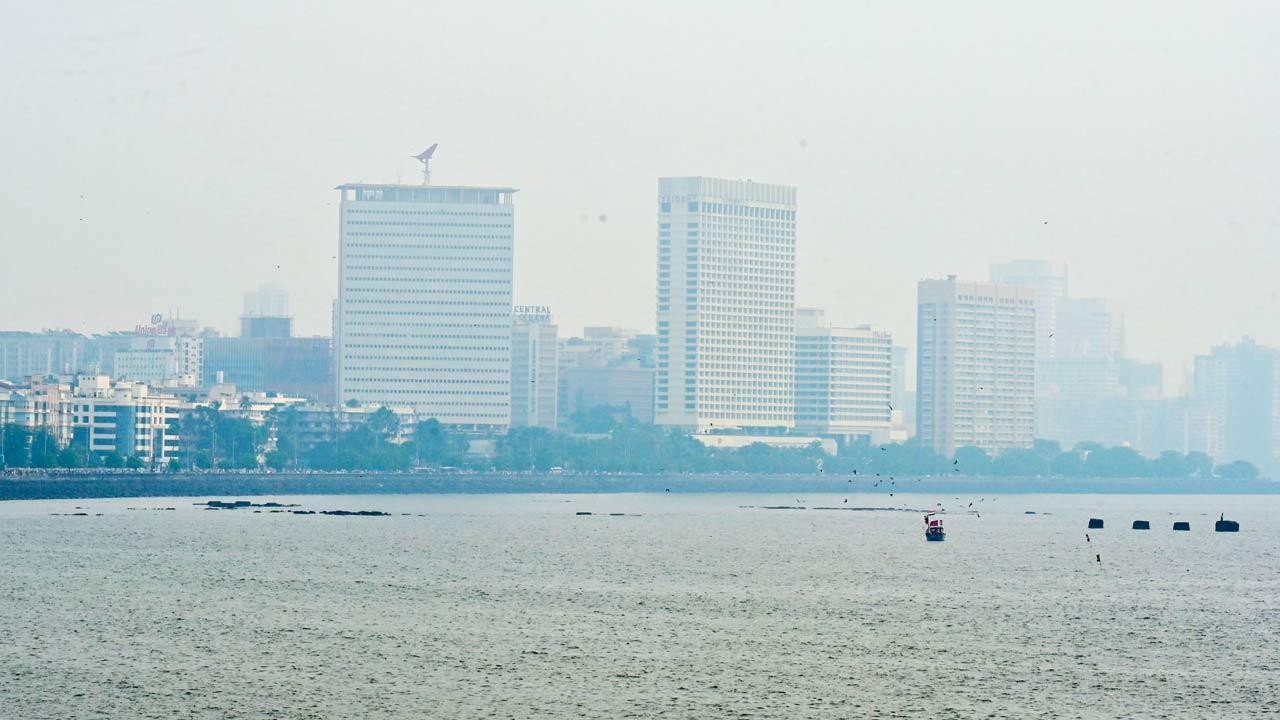Experts say Mumbai woke up to a blanket of haze on Wednesday thanks to dry air, and warn situation will worsen in next two weeks

Nariman Point is shrouded in dense smog on Wednesday. PIC/SHADAB KHAN
The air quality in Mumbai has declined, with the city’s Air Quality Index (AQI) shifting from the ‘good’ and ‘satisfactory’ categories to ‘moderate’. This shift is attributed to the dry weather and moisture-laden winds carrying stagnant pollutants. Experts predict that air quality is likely to worsen over the next fortnight as colder weather sets in and the festival season kicks off.
ADVERTISEMENT
Explaining the phenomenon, Dr Gufran Beig, senior scientist and former project director of the System of Air Quality and Weather Forecasting and Research (SAFAR), stated that the delayed onset of La Nina is a significant concern. La Nina typically brings stronger winds and more dynamic atmospheric circulation, which helps disperse pollutants, particularly in northern India. However, La Nina is not expected to develop until late October or November this year. Until then, neutral weather conditions will contribute to stagnant surface winds, worsening the pollution problem, especially in peninsular and western India.
Talking about the AQI in the city on Wednesday Sumaira Abdulali, convenor of Awaaz Foundation, said, “All our measurements focus on PM2.5 levels, which are particularly harmful to health. Awaaz Foundation will continue to provide daily pollution updates and health advisories throughout the winter season and beyond. On September 7, 2024, we launched a project offering health advisories on air pollution. While Mumbai's pollution levels have been acceptable since then, on Wednesday, the AQI exceeded 100 at many places in the city, raising concerns.”
Historically, Mumbai’s AQI remains ‘good’ throughout the monsoon, which typically lasts from June until the end of September. Rain helps wash away suspended particulate matter, keeping pollution in check. However, as the dry season approaches, pollution levels are expected to rise.
Beig added, “There’s a 30 per cent likelihood that, like in 2022, peninsular India, including the western parts of the country, could be affected by bad air quality. We can’t say for certain at this point. The World Meteorological Organisation (WMO) has indicated a 55 per cent chance of entering a La Nina phase. There are early signs, like the lack of rainfall and heavy moisture in the air, which is causing pollutants to hang around. The late withdrawal of the monsoon could also contribute to these conditions.”
A growing concern
During October 2023, Mumbai experienced a severe air pollution crisis, with particulate matter concentrations reaching dangerously high levels. In some parts of the city, these concentrations exceeded permissible daily limits by three to four times, as observed by an IndiaSpend analysis of air quality data from 20 locations across Mumbai.
PM2.5, which refers to particulate matter 30 times finer than a human hair, is of particular concern due to its ability to penetrate deep into the lungs. While vehicular emissions have been a longstanding contributor to the city's air pollution, ongoing construction work and specific weather conditions that trap pollutants in the atmosphere have exacerbated the issue.
According to SAFAR, the overall air quality of Mumbai on Wednesday evening was 130 (moderate). The PM2.5 levels at Malad, Colaba, Mazagaon, Borivli, Chembur and Bandra Kurla Complex around the same time were 138 (moderate), 253 (poor), 117, 131, 157 and 127 respectively.
Health risks
Pulmonologists and health experts have observed a yearly spike in respiratory issues, such as chronic obstructive pulmonary disease (COPD) and asthma, beginning in October. Several studies have already shown the impact of air pollution on not only respiratory organs but also brain and reproductive organs. Last year, a first pan-India study conducted by scientists from four institutes found a direct correlation between air pollution and health. The study stated that areas with poor air quality and higher emissions of PM2.5 are more likely to have COVID-19 infections and related deaths. “Every year, we witness an increase in patients with respiratory problems from October onwards, coinciding with the deterioration in air quality,” said a pulmonologist from a leading hospital in the city.
Call for urgent action
Environmental experts are calling for immediate measures to control air pollution, including better regulation of vehicular emissions and dust control at construction sites. Abdulali has been writing to the BMC and state government demanding that the civic body issue public health warnings on days when the AQI reaches poor, very poor or severe/critical levels. Organisations across the state have been demanding that urban local bodies mandatorily issue timely health advisories publicly to alert citizens about ‘bad air days. Beig too has been urging the state government and urban local bodies to start issuing such alerts. AQI forecasting and sending health alerts will raise public awareness, ultimately resulting in a reduction in health risk, activists say.
Health problems linked to air pollution
Weakened immunity: Even short-term exposure to high pollution levels can cause allergic reactions and seasonal illnesses. Many residents experience persistent colds, coughs, and fatigue due to the strain on their immune systems. Respiratory conditions: Inhaling pollutants irritates the lungs and airways, leading to asthma, bronchitis and COPD. Other issues: Prolonged exposure to poor air quality has also been linked to increased risks of heart attacks, strokes and diabetes, according to multiple studies.
Do’s
>> Check daily air pollution forecasts
>> Walk, bike or carpool
>> Use a dehumidifier or AC to reduce moisture
>> Ensure exhaust fans in homes are working
Don’t
>> Avoid congested roads and rush hours.
>> Avoid exercising outdoors when pollution is high
>> Don’t burn wood or trash
>> Don’t smoke indoors
>> Minimise use of air freshener
 Subscribe today by clicking the link and stay updated with the latest news!" Click here!
Subscribe today by clicking the link and stay updated with the latest news!" Click here!







